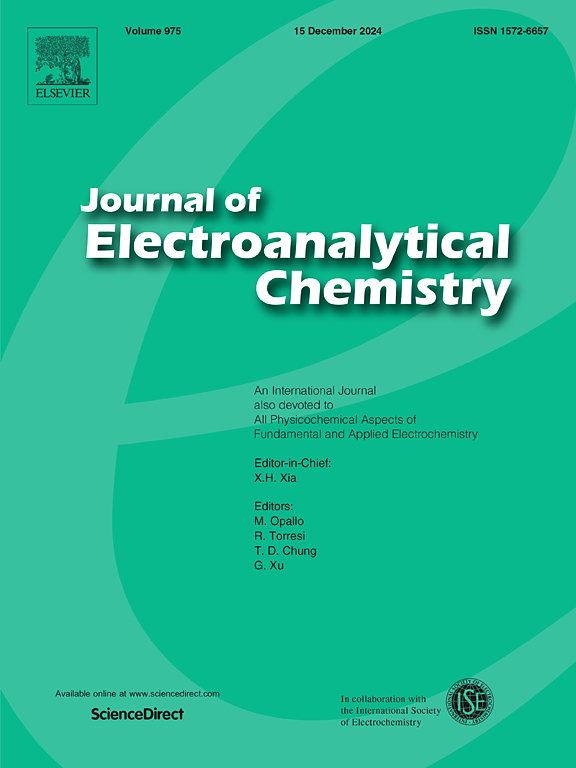基于自组装驱动动态封装的自修复液态金属氧化石墨烯阳极,用于稳定锂离子存储
IF 4.1
3区 化学
Q1 CHEMISTRY, ANALYTICAL
引用次数: 0
摘要
锂离子电池因其高能量密度和长循环寿命在便携式电子设备和电动汽车市场占据主导地位。然而,传统的合金基负极材料(如Si、Bi和Sn)仍然存在体积膨胀大、电极粉化严重、锂扩散动力学慢、库仑效率低的问题。固有高容量液态金属(LM)材料通过其独特的可变形液体特性,有效地减轻了传统合金阳极在循环过程中的体积变形。具体来说,三元合金在脆化过程中,固相可逆地转变为二元液体结构,相变行为使材料具有自愈能力,能够自发修复循环过程中产生的裂纹或粉状结构。本研究提出了一种基于GaSn共晶合金(EGaSn)的自组装动态封装策略,其中液态金属纳米液滴通过氧化石墨烯(GO)的液相自组装被封装。得到的LM-rGO阳极具有优异的比容量(在0.5 A g−1下循环100次后为779.29 mAh g−1)和优异的循环稳定性(在2 A g−1下循环500次后为453.77 mAh g−1)。这种封装策略不仅减轻了合金基阳极的体积膨胀效应,而且通过其独特的应力缓冲机制和三维导电网络的协同作用,增强了锂离子的输运动力学。这一策略为开发具有自我修复功能的高性能锂离子电池提供了一种创新的解决方案。本文章由计算机程序翻译,如有差异,请以英文原文为准。
Self-healing liquid metal-rGO anode via self-assembly driven dynamic encapsulation for stable lithium-ion storage
Lithium-ion batteries have become dominant in the markets for portable electronic devices and electric vehicles owing to their high energy density and long cycle life. However, traditional alloy-based anode materials (such as Si, Bi, and Sn) still suffer from significant volume expansion, severe electrode pulverization, slow lithium diffusion kinetics, and low Coulombic efficiency. Intrinsic high-capacity liquid metal (LM) materials effectively mitigate the volume deformation of traditional alloy anodes during cycling through their unique deformable liquid properties. Specifically, during delithiation, the ternary alloy solid phase reversibly transforms into a binary liquid structure, and the phase transformation behavior endows the material with self-healing ability, which can spontaneously repair the cracks or pulverized structures generated during cycling. This study proposes a self-assembled dynamic encapsulation strategy based on a Ga![]() Sn eutectic alloy (EGaSn), in which liquid metal nanodroplets are encapsulated via the liquid-phase self-assembly of graphene oxide (GO). The resulting LM-rGO anode exhibits excellent specific capacity (779.29 mAh g−1 after 100 cycles at 0.5 A g−1) and outstanding cycling stability (453.77 mAh g−1 after 500 cycles at 2 A g−1). The encapsulation strategy not only mitigates the volume expansion effect of alloy-based anodes but also enhances the lithium-ion transport kinetics through the synergy between its unique stress-buffering mechanism and the three-dimensional conductive network. This strategy provides an innovative solution for the development of high-performance lithium-ion batteries with self-healing functionalities.
Sn eutectic alloy (EGaSn), in which liquid metal nanodroplets are encapsulated via the liquid-phase self-assembly of graphene oxide (GO). The resulting LM-rGO anode exhibits excellent specific capacity (779.29 mAh g−1 after 100 cycles at 0.5 A g−1) and outstanding cycling stability (453.77 mAh g−1 after 500 cycles at 2 A g−1). The encapsulation strategy not only mitigates the volume expansion effect of alloy-based anodes but also enhances the lithium-ion transport kinetics through the synergy between its unique stress-buffering mechanism and the three-dimensional conductive network. This strategy provides an innovative solution for the development of high-performance lithium-ion batteries with self-healing functionalities.
求助全文
通过发布文献求助,成功后即可免费获取论文全文。
去求助
来源期刊
CiteScore
7.80
自引率
6.70%
发文量
912
审稿时长
2.4 months
期刊介绍:
The Journal of Electroanalytical Chemistry is the foremost international journal devoted to the interdisciplinary subject of electrochemistry in all its aspects, theoretical as well as applied.
Electrochemistry is a wide ranging area that is in a state of continuous evolution. Rather than compiling a long list of topics covered by the Journal, the editors would like to draw particular attention to the key issues of novelty, topicality and quality. Papers should present new and interesting electrochemical science in a way that is accessible to the reader. The presentation and discussion should be at a level that is consistent with the international status of the Journal. Reports describing the application of well-established techniques to problems that are essentially technical will not be accepted. Similarly, papers that report observations but fail to provide adequate interpretation will be rejected by the Editors. Papers dealing with technical electrochemistry should be submitted to other specialist journals unless the authors can show that their work provides substantially new insights into electrochemical processes.

 求助内容:
求助内容: 应助结果提醒方式:
应助结果提醒方式:


